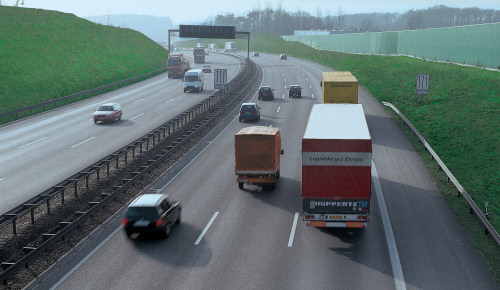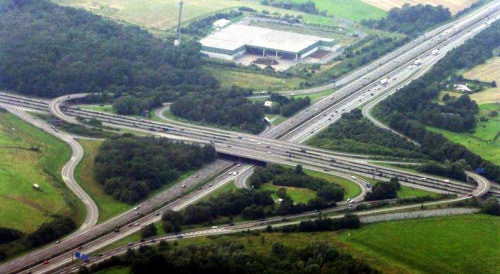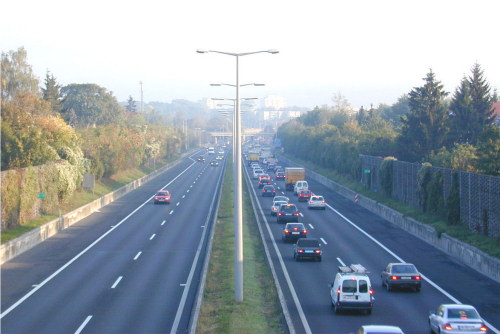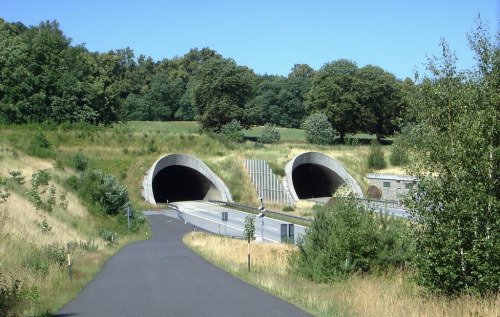Autobahn Design

Typical section of Autobahn
To provide for unimpeded, high-speed traffic flow is the general rule for the Autobahn design. Most Autobahns feature the following design elements (Unimproved older segments excluded)
- Two, three, or occasionally four lanes per direction. Rural section lanes are generally 3.75 meters wide except the left lane of newer three lane segments, which is 3.5 meters wide. On urban sections, all lanes are 3.5 meters wide.
- A landscaped vegetated median 3.5 or 4 meters wide (In urban areas, 3 meters). A double-sided guardrail runs in the middle. Blinders are often used on curves. Some newer sections have concrete barriers instead of vegetated medians.
- Outside emergency shoulders and long acceleration and deceleration lanes.
- Full grade separation and access control, generally provided by half cloverleaf interchanges at exits and full cloverleafs or directional interchanges at Autobahn crossings. Interchanges are generally well spaced, sometimes exceeding 30 km between.
- Grades of 4% or less. Climbing lanes are provided on most steep grades.
- Gentle and well banked curves.
- Freeze resistant concrete or bituminous surface.
- Roadbed and surface measuring about 68 cm (27 inches) in thickness.
Autobahns also feature the following amenities:
- Reflector guide posts at 50 meter intervals.
- Frequent parking areas, often equipped with toilets.
- Extensive and ample service areas featuring gas stations, restaurants, and hotels.
- Automated traffic and weather monitoring and electronic signs providing dynamic speed limits and/or advance warning of congestion, construction, accidents, and fog.
- Emergency telephones every 2 km.
- Pre-signed detour routes to facilitate emergency closures.
- Standardized signage.
- Wildlife protection fencing, crossover tunnels and "green bridges".
Maintenance is superb. Crews inspect every square meter of the system periodically using vehicles with high-tech road scanning equipment. If a fissure or other defect is found, the entire road section is replaced. Barriers, signs, and other features are also well maintained.

Autobahn Intersection (Autobahnkreuz) Breitscheid-Ratingen
Urban Autobahns
Generally the mainline Autobahn routes avoid the metropolitan cores. Instead, spur routes provide Autobahn access into and within the cities. These spurs are usually built as urban Autobahns (Stadtautobahn). Design features of urban Autobahns include six or eight lane elevated or depressed roadways with frequent and more closely-spaced diamond interchanges. The rural signage standards are suspended in favor of more appropriate closely-spaced overhead signs. There are sometimes no emergency phones or roadside reflector posts. Tunnels, overpasses, and sound barriers are more frequent and nighttime illumination is often provided.

Congestion building up on a
Urban Autobahn (Stadtautobahn). Due to almost constant
heavy traffic
sections like this often have speed limits, sometimes as slow as 80 km/h.
Tunnels and bridges
To help maintain safe grades, the Autobahn system is well-endowed with tunnels and bridges. Valley bridges (Talbrücke) are often over 500 meters high and sometimes over 1 kilometer long. The Autobahn system has over 65 tunnels, both through mountains as well as in urban areas. As a result of the tunnel disasters elsewhere in Europe during the past years, extra emphasis has been placed on tunnel safety. All Autobahn tunnels have extensive safety systems including 24-hour video monitoring, motorist information radio and signs, frequent refuge rooms with emergency telephones and fire extinguishers and emergency lighting and exits. They also feature smoke ventilation systems.

Autobahn Tunnel in southern Germany.